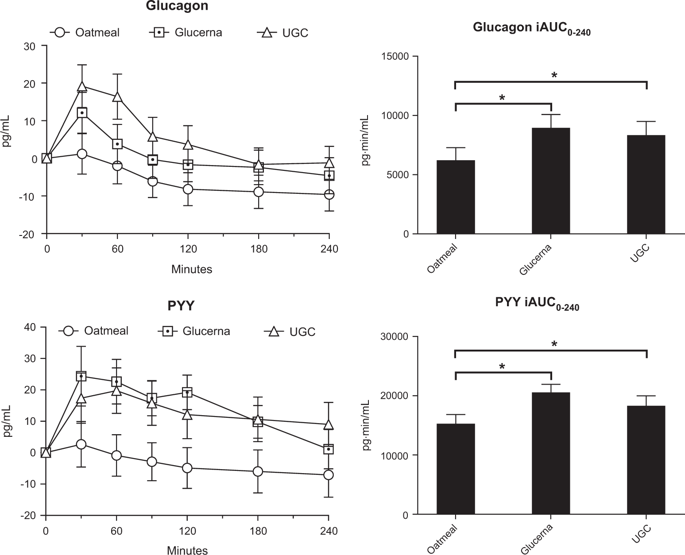当前位置:
X-MOL 学术
›
Nutr. Diabetes
›
论文详情
Our official English website, www.x-mol.net, welcomes your
feedback! (Note: you will need to create a separate account there.)
Effect of diabetes-specific nutrition formulas on satiety and hunger hormones in patients with type 2 diabetes.
Nutrition & Diabetes ( IF 4.6 ) Pub Date : 2019-09-24 , DOI: 10.1038/s41387-019-0093-x Adham Mottalib 1, 2 , Martin J Abrahamson 1, 3 , David M Pober 1 , Rani Polak 1, 4 , Ahmed H Eldib 1 , Shaheen Tomah 1 , Sahar Ashrafzadeh 1 , Osama Hamdy 1
Nutrition & Diabetes ( IF 4.6 ) Pub Date : 2019-09-24 , DOI: 10.1038/s41387-019-0093-x Adham Mottalib 1, 2 , Martin J Abrahamson 1, 3 , David M Pober 1 , Rani Polak 1, 4 , Ahmed H Eldib 1 , Shaheen Tomah 1 , Sahar Ashrafzadeh 1 , Osama Hamdy 1
Affiliation

|
OBJECTIVES
Diabetes-specific nutritional formulas (DSNFs) are frequently used by patients with type 2 diabetes (T2D) as part of nutrition therapy to improve glycemic control and reduce body weight. However, their effects on hunger and satiety hormones when compared to an isocaloric standardized breakfast are not fully understood. This study aims to evaluate the postprandial effects of two DSNFs-Glucerna (GL) and Ultra Glucose Control (UGC)-versus oatmeal on selected satiety and hunger hormones.
METHOD
After an overnight fast, 22 patients with T2D (mean age 62.3 ± 6.8 years, A1C 6.8 ± 0.7%, body weight 97.4 ± 21.3 kg, and BMI 33.2 ± 5.9 kg/m²) were given 200 kcal of each meal on three separate days. Blood samples for amylin, cholecystokinin (CCK), ghrelin, glucagon, leptin, and peptide-YY (PYY) were collected at baseline and 30, 60, 90, 120, 180, and 240 min after the start of each meal. Incremental area under the curve (iAUC0-240) for each hormone was calculated.
RESULTS
iAUC0-240 for glucagon and PYY were significantly higher after GL and UGC than after oatmeal (p < 0.001 for both). No difference was observed between the three meals on postprandial amylin, CCK, ghrelin, and leptin hormones.
CONCLUSIONS
Intake of DSNFs significantly increases secretion of PYY and glucagon, two important satiety hormones. While subjective satiety was not directly evaluated, the increased effect on satiety hormones may partially explain the mechanism of body weight loss associated with DSNF use.
中文翻译:

糖尿病特有的营养配方对2型糖尿病患者饱腹感和饥饿激素的影响。
目的2型糖尿病(T2D)患者经常使用糖尿病特定的营养配方(DSNF)作为营养疗法的一部分,以改善血糖控制和减轻体重。但是,与等热量的标准化早餐相比,它们对饥饿和饱腹激素的作用尚不完全清楚。这项研究旨在评估两种DSNFs-Glucerna(GL)和Ultra-Glucose Control(UGC)相对于燕麦对餐后对饱腹感和饥饿激素的影响。方法在过夜禁食后,对22例T2D患者(平均年龄62.3±6.8岁,A1C 6.8±0.7%,体重97.4±21.3 kg和BMI 33.2±5.9 kg /m²)分别给予三餐200 kcal天。在基线和30、60、90、120、180,每餐开始后240分钟。计算每种激素的曲线下增加面积(iAUC0-240)。结果GL和UGC后,胰高血糖素和PYY的iAUC0-240显着高于燕麦片后(两者的p <0.001)。餐后胰岛淀粉样蛋白,CCK,生长素释放肽和瘦蛋白激素的三餐之间未观察到差异。结论摄入DSNFs可显着增加PYY和胰高血糖素(两种重要的饱腹感激素)的分泌。虽然没有直接评估主观饱腹感,但对饱腹感激素的增强作用可能部分解释了与DSNF使用相关的体重减轻机制。结果GL和UGC后,胰高血糖素和PYY的iAUC0-240显着高于燕麦片后(两者的p <0.001)。餐后胰岛淀粉样蛋白,CCK,生长素释放肽和瘦蛋白激素的三餐之间未观察到差异。结论摄入DSNFs可显着增加PYY和胰高血糖素(两种重要的饱腹感激素)的分泌。虽然没有直接评估主观饱腹感,但对饱腹感激素的增强作用可能部分解释了与DSNF使用相关的体重减轻机制。结果GL和UGC后,胰高血糖素和PYY的iAUC0-240显着高于燕麦片后(两者的p <0.001)。餐后胰岛淀粉样蛋白,CCK,生长素释放肽和瘦蛋白激素的三餐之间未观察到差异。结论摄入DSNFs可显着增加PYY和胰高血糖素(两种重要的饱腹感激素)的分泌。虽然没有直接评估主观饱腹感,但对饱腹感激素的增强作用可能部分解释了与DSNF使用相关的体重减轻机制。
更新日期:2019-09-24
中文翻译:

糖尿病特有的营养配方对2型糖尿病患者饱腹感和饥饿激素的影响。
目的2型糖尿病(T2D)患者经常使用糖尿病特定的营养配方(DSNF)作为营养疗法的一部分,以改善血糖控制和减轻体重。但是,与等热量的标准化早餐相比,它们对饥饿和饱腹激素的作用尚不完全清楚。这项研究旨在评估两种DSNFs-Glucerna(GL)和Ultra-Glucose Control(UGC)相对于燕麦对餐后对饱腹感和饥饿激素的影响。方法在过夜禁食后,对22例T2D患者(平均年龄62.3±6.8岁,A1C 6.8±0.7%,体重97.4±21.3 kg和BMI 33.2±5.9 kg /m²)分别给予三餐200 kcal天。在基线和30、60、90、120、180,每餐开始后240分钟。计算每种激素的曲线下增加面积(iAUC0-240)。结果GL和UGC后,胰高血糖素和PYY的iAUC0-240显着高于燕麦片后(两者的p <0.001)。餐后胰岛淀粉样蛋白,CCK,生长素释放肽和瘦蛋白激素的三餐之间未观察到差异。结论摄入DSNFs可显着增加PYY和胰高血糖素(两种重要的饱腹感激素)的分泌。虽然没有直接评估主观饱腹感,但对饱腹感激素的增强作用可能部分解释了与DSNF使用相关的体重减轻机制。结果GL和UGC后,胰高血糖素和PYY的iAUC0-240显着高于燕麦片后(两者的p <0.001)。餐后胰岛淀粉样蛋白,CCK,生长素释放肽和瘦蛋白激素的三餐之间未观察到差异。结论摄入DSNFs可显着增加PYY和胰高血糖素(两种重要的饱腹感激素)的分泌。虽然没有直接评估主观饱腹感,但对饱腹感激素的增强作用可能部分解释了与DSNF使用相关的体重减轻机制。结果GL和UGC后,胰高血糖素和PYY的iAUC0-240显着高于燕麦片后(两者的p <0.001)。餐后胰岛淀粉样蛋白,CCK,生长素释放肽和瘦蛋白激素的三餐之间未观察到差异。结论摄入DSNFs可显着增加PYY和胰高血糖素(两种重要的饱腹感激素)的分泌。虽然没有直接评估主观饱腹感,但对饱腹感激素的增强作用可能部分解释了与DSNF使用相关的体重减轻机制。









































 京公网安备 11010802027423号
京公网安备 11010802027423号